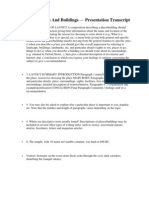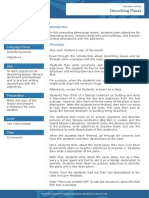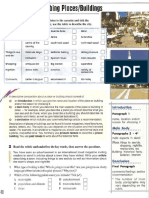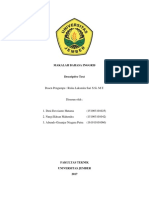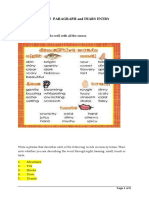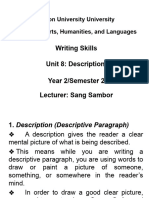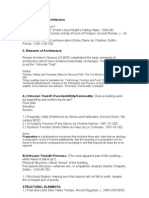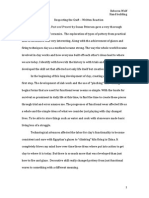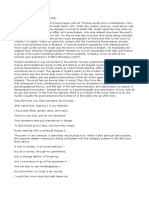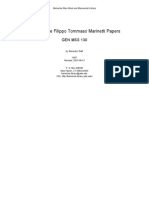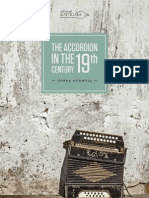Ecole Canadienne de Tunis 4th grade Unit I – In community
Sub-unit 1: What’s in a neighbourhood
The Descriptive Text
1. Components of the descriptive text
As the descriptive text is based on adjectives, adverbs, comparisons (or
similes) and metaphors, it should attract the reader’s senses. We call it a
sensory description. A sensory description does not always have to include
all senses; each sense should be employed when appropriate.
The readers should be able to reconstruct in their minds the described image.
It should seem real. A good description should make the reader feel “there”.
When writing a descriptive text, ask yourself the following questions: What
can the reader: See? Hear? Smell? Taste? Feel?
Examples:
Instead of saying, “I enjoyed my visit to the museum”, you can describe
your favourite painting: “The painting was a field of flowers, with deep
and rich blue and yellow colours over vibrant green spots that seemed
to call you to reach out and pick them.”
2. Structure of the descriptive text
Every text should have a coherent and well organised structure. Before
starting the description, you should put your described object into context.
Start with a narrative introduction and close with a short narrative
conclusion.
Narrative introduction + Descriptive Body + Narrative or descriptive conclusion
Example:
“My life is always crowded with appointments, meetings and schedules. When I
need a break, it has to be somewhere quiet, serene and relaxing. The little resort
town of Nevica is all of those things. It is my favourite place for a weekend break.
1
�Ecole Canadienne de Tunis 4th grade Unit I – In community
Sub-unit 1: What’s in a neighbourhood
There are huge, grey mountains all around the town, and there is snow on the
peaks even in summer. The city might be humid and sweaty, but Nevica always
has a cool breeze from the mountain, and the air feels cold and pure. We usually
stay in a log cabin on a hillside above the town. Sometimes the town is hidden by
low clouds, so the cabin seems to be alone in a clearing in the pine forest, with a
sea of clouds just below.
It is true that I come to this little heaven only on breaks and holidays, but Nevica
will always have a charm that makes it so special to my heart.”
Description of a place:
To describe a place, it is important to follow one specific spatial direction.
The writer should imagine him/herself in the place he/she is describing and
then follow a coherent movement of the eyes. For example, the description
can go from right to left or the other way around. It could also go from the
centre to the peripheries (external surface) or the other way around.
Example:
“One of the most famous cities in Italy is Venice. It gets its popularity from its
history and scenery. Venice has been established during the reign of the Roman
Empire. When I think of Venice, the first thing which comes to my mind are
canals. During my first visit to the city, I entered it through the largest canal
which is at the centre. I was in a long, red boat watching the left and right sides
of the canal decorated with colourful flowers, lively buildings and cosy shops.
Floating through the canals for a whole afternoon, the boatman took me to
smaller water paths that crossed the city in length and width. As the way
became smaller, the charm became more enthralling. It was a memorable
experience.”
Moreover, the description should go from general to more precise, not the
other way around. Therefore, if describing your neighbourhood, say, “High
Street has many shops. My favourite is a small corner café where the
atmosphere is relaxed and friendly.” This is better than “There is a relaxed
and friendly café on High Street. High Street has many shops.”













